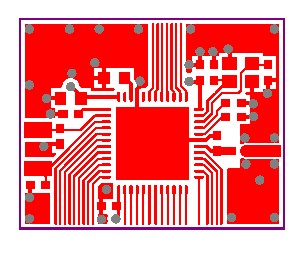Hello, I am designing a custom 2layered PCB board with NRF52832 IC. I have followed the reference design given in IC's datasheet as shown in the figure. Please provide the PCB stack up details for 2 layered board.

Hello, I am designing a custom 2layered PCB board with NRF52832 IC. I have followed the reference design given in IC's datasheet as shown in the figure. Please provide the PCB stack up details for 2 layered board.

All the Nordic 2 layer designs I am aware of are based on 0.062 inch (~1.6mm) FR4 boards. The reason for this is it has become bit of an industry standard over the years and at this point most of the through hole connectors are designed for it and also it is easy for board vendors to get inexpensive 0.062 material. Plus 0.062 has a reasonable rigidity for products.
So that being said you are sourcing an 0.062 inch FR4 board.
However, all FR4 boards are not the same and vary by vendor. You should get an idea of the final Er for your board from your vendor and model the waveguides using your assumptions to make sure it will work. Er for FR4 ranges from about 4.2 to 4.6 at 2.4GHz. Optionally you could spec the coplanar output as 50ohm on your design drawings and your vendor will be able to ensure it is 50ohms. This is normally an extra service at some cost.
What really worries me about your design is the sheer dearth of vias, especially under the nRF where I do not see any. You should take another look at the reference design and get the ground vias correct and if you wish to have the design reviewed, please repost with the ground layer as well.
Hello Thank you for the info. I didn't get the term waveguide". What do you mean by a waveguide? Is it pcb antenna?
All microstrips, stiplines and coplanar waveguides are examples of RF circuits designed to propagate electromagnetic waves across a PCB. They have geometry that is specific to both the board material and the types of RF circuits involved.
The models for pcb waveguides can be rather math heavy but most all the modeling work is done in software. A popular free app for modeling waveguides is Avago's AppCad. You should always check your design assumptions for the waveguides in a modeling application.
And a PCB antenna is also a type of waveguide. In the case of the pcb antenna it is a waveguide designed to transform the characteristic impedance of the board to the characteristic impedance of free space.